











I think we can all agree The United Methodist Church has been through the wringer this year. We are the “hands and feet of Christ”, but we can’t seem to fall into step with one another. And our spirits bear the marks of new bruises and scars as we fight over who gets to set the pace. We leave 2022 and enter 2023 with a
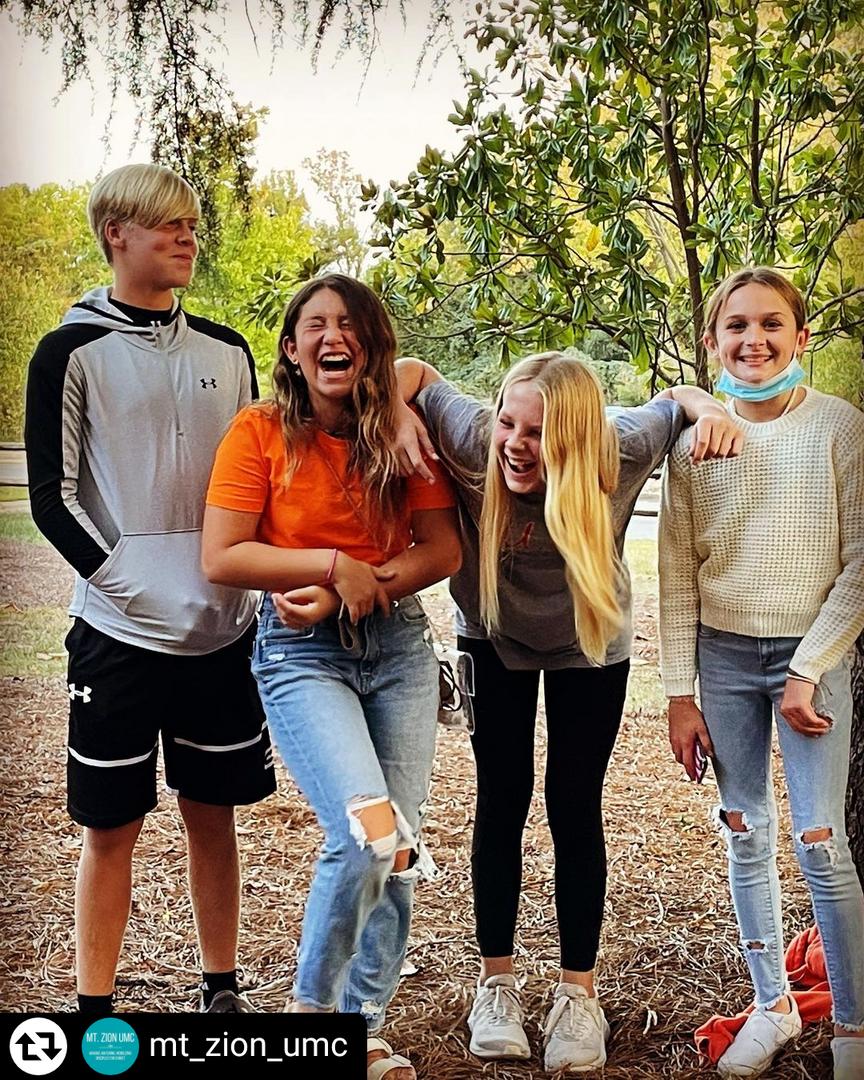
lot of questions, a lot more skepticism, and maybe even some disenchantment. It’s hard to see the future clearly through the haze of heated debates and picking sides.
And yet, here we are in the season of Advent where we anticipate the coming of the Prince of Peace; the One who brings together the lion
and the lamb The One who will raise every valley, make low every mountain, and make straight every winding road The One who promises to prepare a path for us, to go before us, to never leave us. It is through this Messiah, Jesus Christ, that we find our hope, purpose, and mission.
As we look back on 2022 for United Methodists in Western North Carolina, we are choosing to look not at the things that divide us – we have all heard more than enough about that –but rather on the things that unite us, like our faith and salvation through Jesus Christ Throughout the magazine, you will notice that each story is attached to a “People of God” statement. Together, these statements tell the story of the United Methodist expression of the Body of Christ. These stories of congregations and people living out their faith in Jesus celebrate all that makes us proud to be United Methodist.
In recent conversations with colleagues, friends, and church members, I have often heard the question raised on how we move forward from here, but it occurs to me this question implies that we have come to a halt, and we need to get back in motion That is simply not true. The Body of Christ has never stopped moving. United Methodists across Western North Carolina, and around the globe, have not stopped loving God and their neighbors It is our honor to share a few of their stories with you as we thank God for the ministry of faithful United Methodists



P.S. I would be remiss if I didn’t take some space here to share credit with and offer my gratitude to the incredible Lindsay Hampton, WNCC Associate Director of Communications This magazine makes its way into the world in large part due to your hard work and creative effort. Thanks, Lindsay! I couldn’t do it without you.



We invite you to listen to this conversation that took place during the 2022 Annual Conference. On Thursday evening, June 16th, Bishop Carter, along with a group of clergy from across the Conference, of various races, ages, genders, and ministry roles sat down for a panel discussion on the future of The UMC. Their goal was to answer a question you may have asked yourself a time or two – will there be a place for me in the continuing United Methodist Church?



As the people of God in the world, every moment the Holy Spirit fills us, moves us, and continually shapes us into something more But, what does this filling, moving, and shaping really mean? What is a Spirit-filled person of God?
Sometimes Spirit-filled looks like “Coach” who is the Church Council Chair of First UMC in Maiden. Noticing the hungry people in his community, he felt the clear call of the Spirit to start a “Blessing Box” ministry He invested months organizing church members, individuals, community organizations, schools, and even the town’s government to work collaboratively on this mission – a faithful response to Jesus’ call to “feed my sheep”.
Soon, hundreds of pounds of food were donated to and taken from a 12-foot cubic square box every month that was in his church’s parking lot. Whenever supplies ran low, Coach simply put the word out and the community responded. He pulled together a team that gave hundreds of hours to be certain the Blessing Box always had food according to their mantra of, “Take what you need, leave what you can ”
One month, the team noticed an unusually high volume of food was being taken. The box was routinely getting emptied shortly after it was restocked. One day, after restocking the Blessing Box, Coach decided to sit in his truck in the far corner of the parking lot and watch. Sitting there, he thought about the generous people who had given the food to fill the box, and he began to wonder about other people who took advantage of this generosity. He later admitted to getting a bit worked up about it - just as someone came up to the Blessing Box and proceeded to remove all the food items he had just put into it. He got out of his car, fully intending to confront the person and give them a piece of his mind Then, he realized the person was in a wheelchair.
Forty-five minutes later, Coach found himself in his pastor’s office sharing what had happened. He said, “Preacher, the darndest thing just happened to me – in fact, something came over me!

He went on to describe how he stepped out of truck with some very un-Christian things on the tip of his tongue, but midway across the parking lot, the same Spirit that called him to feed hungry people in his community opened his eyes to the hungry person right in front of him. His steps and his heart slowed as the Spirit replaced his anger with loving compassion. He found himself saying, “I couldn’t help noticing that you are taking a good bit of food. Is there something else you might need?”
The Spirit stirred compassionate curiosity in Coach and he found himself talking with the person at length. The man in the wheelchair had a room in a dilapidated boarding house right down the street, and of the several men in the house, he was the only one who was still mobile. He was collecting food for the whole house In a daze, Coach finished his account by saying, “Preacher, I don’t know what came over me. Before he rolled away, I asked him if I could pray for him, right there in the parking lot. I’ve NEVER offered to pray for someone like that – let alone actually do it. But, I did I prayed for him right then I think the Spirit filled me with words that I didn’t know I had to share.”
The people of the United Methodist Church are Spirit-filled people. When we are at our best, we are making ourselves available for the Spirit to work in us and through us to impact the world around us. Being in tune with how the Spirit is shaping us as individuals and as congregations is foundational to our ongoing development and shared mission as a denomination.

The Apostle Paul points to the movement of the Spirit in us in Ephesians 3:14-21. These words, which were written to people who were forming the early church, are still a moving prayer for us today. It’s a prayer that points us to the power of God’s love that is continually at work in us through the Holy Spirit It is through the Spirit that we are empowered, “made complete,” and can “accomplish infinitely more than we might ask or think”
Vital churches across our Conference are finding ways to focus on the movement of the Spirit around them and within them rather than solely focusing on getting people to show up for programs. Instead of focusing on ways to simply get people to "show up," vital churches are equipping people to pay attention to where God is already moving in us, with us, and through us.

The Spirit is moving at Growth Co., a new church plant for people in their 20s and 30s, who gather online weekly to collectively explore the fusion of spirituality and everyday life and discuss what that looks like in practice After a recent gathering, Lexi, the pastor, texted a couple who had been attending regularly but had not attended that night. When they responded, she found out they were reluctant to attend because they had just been in a marital argument and didn’t feel worthy to join a “church thing "
“This is EXACTLY the place you need to be and the people you need to be with!” Lexi exclaimed. In that moment, the Spirit gave Lexi the words to proclaim what fusion of their spirituality and their everyday life could look like.



The Spirit is moving at La Luz de Cristo UMC in Asheboro. Jaidy Smith, who leads a Fresh Expression there talks about Francisco Portugal, a church member who is always eager to pray, preach, and lead Bible Study, and is always willing to lend a helping hand to those around him. He says he is just trying to be obedient to the voice and calling of the Holy Spirit every day His faithfulness to the Spirit leads him to help bridge the cultural gap between the Hispanic community and the elderly American church members He is passionate about God and encourages others to follow the voice of the Holy Spirit.



The Spirit is moving at Gethsemane UMC, a church that is being surrounded by the expanding suburbia of Greensboro. GUMC is a Transformation Journey Church that is seeking to discern what it means to be the Church differently, since they are no longer in a rural community, and how they can do that. They are actively listening for God’s voice around them, sharing what the Spirit is stirring in them, asking each day what and who God is calling them to pray for, and discerning how they can actively engage with that prayer The movement of the Spirit is both unsettling them AND inspiring them!
The Spirit is moving at Hope Fellowship, a young church plant in Sparta. Pastor Ben Gatton was talking with one of the church plant’s participants in the parking lot of the local diner where they worship every week. The regular attendee shared, “You know, I told my wife the other day that I have felt better over the last few months than I have in years. When she asked me why, I said, ‘I think it's all these damn church people I am around all the time!'”
He had not attended church in 40 years.



Now, after connecting with Hope Fellowship through one of their outreach programs, he has become a member of the Sparta UMC collective and is an active participant in both campuses.


The Spirit is moving in Pastor Raymundo Villanueva. As he was discerning God’s call to serve in two places – Hickory and Morganton - one of his church members in Hickory asked him to meet with their friend who wanted to have their child baptized. When he visited with the mother to explain what baptism means, he discovered that she was not baptized herself As they talked, she decided to get baptized too! Pastor Raymundo said, “The confirmation that God is calling me to both places came when I found out that this family lives in Morganton and it is too far for them to drive to Hickory for church. So, I invited them to the new bilingual ministry in Morganton, called Fiesta Church. The Holy Spirit is at work and blessing us as we go in Jesus’ name!”
We all long for more of these moments in our own lives. We need to be filled with a sense of potential and hopeful expectation for what the Spirit will stir up in us next. Thankfully, God is relentlessly pursuing us. Imagine what our individual lives and our faith communities could look like if we were singularly focused on pursuing God as the Spirit moves.
For a deep dive into HOW churches can move from an organizational mindset to a Movement mindset, see Sue Nilson Kibbey’s book, Flood Gates




Field education is an important part of many degree programs because of the invaluable experiences gained through working on site with others within the field. Parker Hughes and Chris Malbert, new seminary students at Duke Divinity School, decided to complete their field education this past summer in the Western NC Conference. They had no idea what they were getting into being placed in the rural Smoky Mountain District!

Parker attended UCLA for his undergraduate degree and stayed in Los Angeles working as a bartender after graduation
“I would often serve celebrities at the place I worked,” he shared on a Zoom call we had back in July “It was a busy, stressful environment where you had to be prepared for anything.”
Parker knew he didn’t want to stay in California forever and was feeling a call to ministry. He was accepted at Duke Divinity School and applied for the Pre-Enrollment Field Education Program, which would place him in a church setting to help discern where his call was taking him before starting school in August He was placed at Bryson City UMC under the leadership of Rev. Wayner Dickert for 10 weeks from June to August.
“It was a completely different atmosphere than what I was used to in Cali," Parker said. "I was used to being surrounded by the busyness of a city with millions of people and Bryson City is not like that at all!”
Bryson City UMC is the only United Methodist Church in Swain County, which is located along the


Appalachian Trail and is a gateway to the Great Smoky Mountains National Park. With a population of about 1,800 people, Bryson City is tiny compared to the roughly 4 million in LA.
Rev. Dickert, pastor at BCUMC, is passionate about bringing Fresh Expressions and new ways of doing ministry to the Smoky Mountains of western NC.

“One of my favorite things I’ve gotten to participate in so far is rafting as a form of worship with Wayner and others at Bryson City," Parker reflected. "I didn’t know rafting down a river could be considered ‘church’ or ‘worship’ but I definitely felt God’s presence out in the water. It opened my eyes to see that there are so many ways we can experience God’s love other than sitting in a sanctuary listening to a sermon.”



Chris has a similar story to Parker in that he also came from a more populated area before being placed at a rural church in the Smoky Mountain District for his Field Education Study. He completed his undergraduate education in Chicago before deciding to explore his call to ministry by applying to Duke Divinity School For his Pre-Enrollment Field Education, he was placed at Robbinsville UMC under the leadership of Rev. Eric Reece. Robbinsville is a small town in Graham County with a population of about 850 people. Robbinsville UMC is also the only United Methodist Church in its county


“It’s pretty different from anything I’m used to,” Chris laughed. “Don’t get me wrong, I love it! But it was definitely a little bit of a culture shock coming here.”
Rev. Dickert and Rev. Reece are not only colleagues, but friends. With their churches being only about 30 minutes apart, they can collaborate and share ideas for ministry with each other, especially since their communities are quite similar in size and ambiance. They both love being able to participate as mentors in the Duke Divinity Field Education Program because it gives them a chance to show the future leaders of the Church what ministry can look like in a rural area.
“Part of my calling is mentoring these young adults and showing them that just because we aren’t located in a big city with a lot of resources, doesn’t mean ministry has to be boring and predictable We have fun here in the Smoky Mountains!” Wayner said.
Everyone on the call laughed and agreed “I’m so encouraged about the future of the Church with these leaders.” Rev. Reece said.


Parker and Chris became friends through the program this past summer.
“There’s a special bond formed with all the interns in the program because we were all placed somewhere new with little to no previous knowledge of the environment we were about to be immersed in for 10 weeks,” Chris said “We could all relate to each other in having no idea what we’re supposed to be doing or what our expectations were. I mean, it’s been an amazing experience but I really had no clue what to expect or what I would even be doing.” he laughed.
Neither Chris nor Parker are United Methodists They learned all about The UMC through their internships. They loved getting to work with the laity in the churches and even got to preach some Sundays. Both of them studied theology in college so they were able to take what they learned and apply it to real life.
“Just being with the people of the church is so rewarding,” Chris states “I feel like I’m able to live out my calling of being the Church in our world today. It can be hard with everything going on in society but the rural Smoky Mountains helped me to see that God is still very much a part of our world today.”
"
...the rural Smoky Mountains helped me to see that God is still very much a part of our world today."
-Chris Malbert, Duke Divinity Student
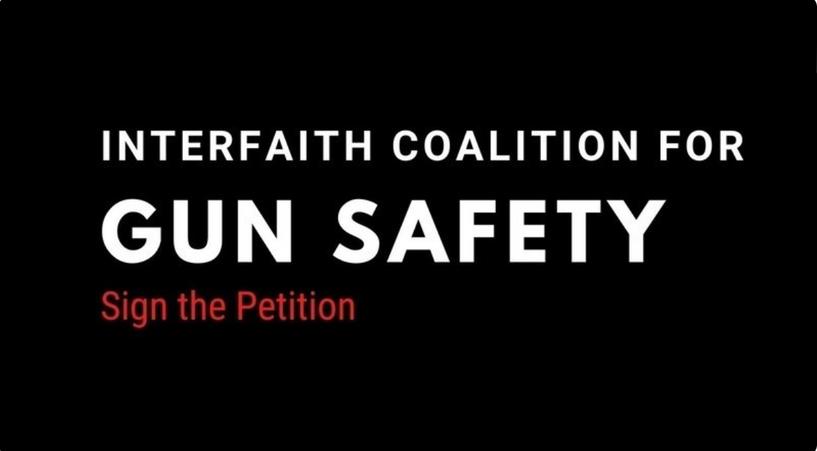

 BY BEN ROGERS WNCC MISSION RESPONSE ASSOCIATE
BY BEN ROGERS WNCC MISSION RESPONSE ASSOCIATE
Many clergy and lay members of churches within the Western NC Conference have joined a petition recently started by Ad Hoc Committee Members of an Interfaith Coalition for Gun Safety
In 2015, a group from Myers Park UMC began meeting to educate themselves on racial issues and to promote antiracism in their congregation. Over the years, they have engaged in discourse on topics with Harvey Gant, Dorothy Counts, Jonathan Wilson-Hartgrove, and many others
Following the mass shootings in Buffalo and Uvalde, the group felt called to focus on these and other senseless killings. Various individuals from churches, temples, and other organizations responded to a call from Myers Park UMC pastor, Rev. James Howell, to help translate the concerns into action; those individuals make up the Ad Hoc Committee proposing the petition.
A desired outcome of the petition, according to John Clarkson from Myers Park UMC, is to “objectively document broad-based support for meaningful gun safety reform to local, state, and federal elected officials”

The reach of the petition is already happening as the coalition held a meeting with Sen. Jeff Jackson in July. During that meeting, Jackson commended the interfaith effort while emphasizing that continued public pressure is the key to convincing elected officials to change their positions.
When asked what pushed him to become involved in the coalition, Rev. Otto Harris, pastor at St. Marks UMC in Charlotte, pointed to Matthew 5:9, in which Jesus pronounces a blessing upon peacemakers
“The Church has been strangely silent on this issue,” said Rev. Harris. “We have an opportunity to contribute to the conversation and lead the community in making peace”
This verse in Matthew is also referenced in the 2016 United Methodist Book of Resolution #3428, “Our Call to End Gun Violence”.
This petition leans on the call “to go far beyond thoughts and prayers to work for systematic changes to improve gun safety”. The coalition recognizes that the recent bipartisan legislation containing gun and school safety measures is encouraging; however, there are still many measures left unaddressed

Mr. Clarkson believes this petition will prompt gun safety conversations within each connected organization and encourage involvement within their larger communities.
“The sacredness of life, the God-given breathed and deemed very good life, is worth cherishing. And I believe that lives become buried bodies when we allow the idolatry of fear, violence, and weapons to cloud our vision of the aforementioned reality.” stated Rev. Nathan Arledge, Pastor of Missions and Community Engagement at Myers Park UMC
“Due to this, it is essential for the faith community to raise a collective voice and call for reform and direct action from our elected officials - local, state, and national. We came together as a coalition to name the abundant love that is God. The love of God has the transformational power to release the captive - from the idolatry of guns, violence, and fear - and to reclaim the narrative of grace, compassion, tenderness, and hope. We found this a common hope for all speaking into these common-sense gun law petitions.”
Consider these thoughts Rev. Harris provided when asked “What’s next?”
1) Read more and sign the petition
2) Invite others to sign the petition

3) If there are concerns or additional ideas, contact the drafters of the petition.
4) Encourage conversations in your congregations, families, and communities
“You’re blessed when you can show people how to cooperate instead of compete or fight That’s when you discover who you really are and your place in God’s family.” Matthew 5:9, The Message
“The thief enters only to steal, kill, and destroy. I came so that they could have life indeed, so that they could live life to the fullest” John 10:10, Common English Bible


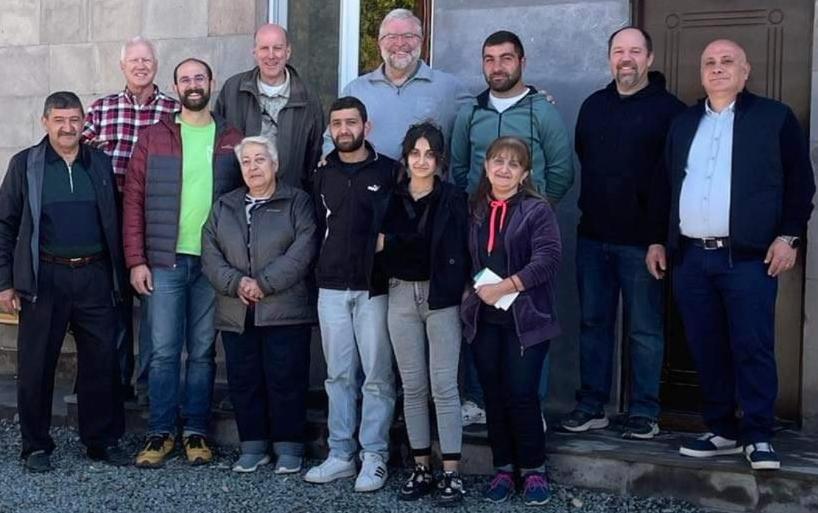

How should we think about God's mission in the Methodist church(es) today? As Christians we are tasked with loving God and loving our neighbor. But to borrow a thought provoking question from Duke Divinity Professor Luke Bretherton, "How do we balance our love for near and distant neighbors?" The book of Acts provides many examples of both seeing
and serving near neighbors and contributing to support the ministry of distant Christian communities. Assuming we don't think we know how to live in Christian community better than the early church, perhaps the interconnected nature of our love for near and distant neighbors can inform our Christian practice today.
I was granted the opportunity to travel to Armenia over the past few weeks to visit the staff and new headquarters of Project AGAPE, a mission of humanitarian aid. This mission has been a partnership of the Western North Carolina Conference and North Carolina Conference for nearly thirty years. As I traveled with two seasoned and two new emissaries from our conferences, I spent my time reflecting on the meaning of mission, and how our continued connection between near and distant churches should help us hold on to the model set out by the early church
This trip was special for me among my cotravelers because of my identity as a fourth generation Armenian American whose ancestors fled the genocide in 1915 So I had a few additional questions to ask as well: What is the connection between my lived experience as an Armenian American, a descendant of genocide survivors in diaspora, and my role as a pastor of The United Methodist Church supporting Project AGAPE? How do I balance my love for Armenia and its Apostolic Church, with my love and service to my United Methodist churches in Western North Carolina?

I don't know how or why God placed me precisely here at this moment, in between the diaspora and the nation state, in between the Methodist and the Apostolic church, between Armenian and


American, between homeland and home, especially at a time when Methodists are feeling the tension of churches pulling away from each other to form new and re-imagined denominations (e.g., Global and United Methodist Churches)
I felt and feel pulled in so many directions, but this is not a new feeling. For a long time I have felt my place in the body of Christ must be that of a ligament I have always felt stretched in different directions trying to hold on to people and ideas that don't seem to mesh well. The purpose of a ligament is to hold the body together. This trip has taught me to attempt to hold together even more than I imagined I was meant for. Perhaps there's a little ligament in all of us. God knows it's an underappreciated part of the body of Christ right now.
Let me tell you what happened last Sunday We had a delicious breakfast as usual and got ready for church. The Armenian Apostolic Church in Vayk is an easy walk from the Project AGAPE center, but we took the van because of the rain As it turned out, the priest was not feeling well, so the service was cancelled. We decided to spend the time in prayer and silent reflection rather than rush off to find another service I offered prayers for my churches at home and family in the U.S. and Armenia.
But just as we were about to make new plans, a series of events led to us staying two more hours on the church grounds and learning much more than we would have if we had left in a hurry. First, the lovely caretaker of the church, Ophelia, offered us bread and coffee - communion - in a way, or at the very least breaking of bread. I certainly saw Christ in her, in her dedication to the church, and her kindness and hospitality towards us


When we sat down for our coffee, the priest came around and began speaking to us. At first I thought he would greet us and return to his quarters, but pretty soon we were knee-deep into what was, first, a debate, then a discussion, then a sermon, then a conversation, and finally a moment of mutual blessing and thanksgiving.
The debate/discussion/conversation hit me personally, as when a doctor strikes the knee to test its reflexes. Fr. Sepuh, priest of the church in Vayk sternly and confidently insisted that I ought to return to live in Armenia His analogy was the Amazon River. Though it is the longest river in the Americas, eventually it flows into the sea and disappears. So, he said, is the identity of Armenians in diaspora. When we left Armenia (my family fled part of Armenia that is now inside the borders of Turkey), we disappeared, becoming unrecognizable, at least from his perspective I have no doubt that this is how many Armenians in Armenia see it And perhaps, as he suggested, this country would be stronger if we all moved back. Though completely unrealistic, I empathized with his agony, having watched his nation suffer for its lack of political power in a region increasingly hostile to its very existence. What could remedy this trouble? More Armenians living in Armenia was his answer

Perhaps he is right, but just as the ligaments of a knee contract under the doctor's mallet, I felt myself recoil at his remarks. I have a home, after all, and it is Western North Carolina. I have a life there, family, community And, it's true, I have family and a home here in Armenia, too. How I wish I could pull both of these homes together. How I wish I could somehow live fully in both. But ligaments are an in-between - neither bone nor joint.
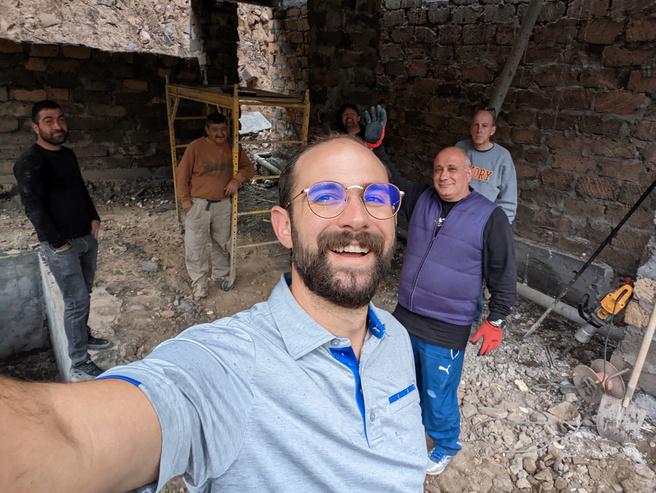
As we listened and reflected together, our project director, Nara Melkonyan, had the opportunity to explain the work of Project AGAPE. My anxious heart relaxed as I realized that just like me, Project AGAPE is an in-between sort of thing, too. It is not a proselytizing organization From its beginning it has been a partnership. Armenians are Christian people, and through many centuries of living on the margins of empire, they have known what it means to carry the cross Project AGAPE is a partnership between United Methodist and Apostolic Churches for the betterment of the Armenian people.


Project AGAPE, from the beginning, has served the margins of the margin, locating itself in the disputed territory of Nogorno Karabakh among people who have had to struggle to survive with very little in terms of outside assistance Now that the 2020 war with Azerbaijan has rendered the project's clients refugees, the focus is on helping these displaced persons reestablish themselves in Armenia
I feel a kinship with those Project AGAPE is trying to serve. For four generations, my family has tried to cling to what was taken from us while at the same time attempting to grow where we've been planted.
Are American Methodists so different? Are we a holiness movement of the Church of England anymore? No. Are we an independent church? Not by our own choosing Even today we are feeling stretched between different scriptural interpretations, different understandings of what it means to be the Church. Our lived experience is summed up in our favorite word: connection No matter what our differences, we know that we are better when we hold together. And no matter what happens to our church, there will still be ligaments, and I am proud to be one of them
As jarring and challenging as our conversation was with Fr Sepuh, I walked away stronger - making meaning in the in-between. And that night another conversation took shape between my brothers and co-travelers Brother Paul Dunham will be accompanying his churches into a newly forming denomination, the Global Methodist Church, while other co-travelers will likely remain with The UMC The details of our future are far from certain, but we found that our love for and dedication to Project AGAPE remains a firm commonality.
John Wesley, in his Letter to a Roman Catholick (sic) famously wrote, "If we do not think alike, can we not love alike?" And as Paul, Bobby, Brian, Allan, and I opened our hearts to one another we learned that, at least when it comes to our work in Armenia, we can and we must. As we Christians seek to balance our love for near and distant neighbors, let us



remember the role of the ligament. When the mallet strikes, the ligament yells, "Hey leg bone! The knee bone is still here! Hey knee bone! The leg bone is still here." (This is based on my expert knowledge of human anatomy) No matter what groups, people, or ideas we find ourselves caught between, let's allow tension to push us towards connectional advocacy. There's another church out there and we need them to be whole!
May Project AGAPE, then, be not only an enduring ligament for our churches, our nations, and our denominations, but a prophecy as well. An in-between project of love and loving alike where Global and United, Methodist and Apostolic, American and Armenian can continue to love those caught in between, as those caught in between, and by the One who came to reveal God's love as, in, and for the in-between.
 BY REV. LUKE EDWARDS ASSOCIATE DIRECTOR OF CHURCH DEVEL
BY REV. LUKE EDWARDS ASSOCIATE DIRECTOR OF CHURCH DEVEL


“This is the most fun I’ve ever had at Annual Conference!” I heard this several times this year as I checked in on our Connect @ AC events throughout the weekend.

On Thursday morning, Rev. Jonathan Brake and the Creation Care Ministry of the WNCC led a hike up Waterrock Knob on the Blue Ridge Parkway, which included some time of spiritual preparation for Annual Conference

Rev. Wayner Dickert, our resident Olympic paddler, led a group of various ages paddling on Lake J. Two participants connected as they paddled and planned to partner in ministry on Lake Norman when they return home.
Rev. Jeremy Morris and Rev. Patrick Ledford gave fly fishing lessons (Patrick brought the metronome).


Jaidymar Smith led a time of intergenerational Bible Devotional Art by the lake. She leads a fresh expression of church called Growing Together that gathers like this every month in Ramseur.



Two groups went out for a round of golf and had a great time
Friday evening was one for the books. As the Recognition of Retiring Clergy let out, Martha Basset and her band kicked off a lively set of folk, Americana, and jazz music. Folks grabbed dinner from the food trucks and pulled up chairs to visit and listen.
Meanwhile, a group gathered at the cross looking over the lake for an oldfashioned hymn sing. Jarvis and Keith Wilson and several members of the Greensboro Ensemble were there so you know there was some heavenly worship happening!
Across the pond at the Nanci Weldon Gym things were getting messy.
Robin Cannon of Messy Church USA, Rev. Mary Miller, Rev. Cathy Davis, and Rev Charles Dirico led an incredible Messy Church for all ages
As Martha Basset and the band wrapped up, I started passing out headphones for the Silent Dance Party I was a bit worried that Methodists might be too shy to bust a move in the courtyard but at least 50 people stopped by to dance, including Rev. Kim Ingram who led us in the electric slide.
Up in the Terrace, a group gathered to attend a live stream of the Seventh Mother Emanuel AME Commemorative Service for the Martyred. There was an unexpected delay in the live stream, so each person offered a prayer. Rev. Dr. Bill White, Jr, who led the group, told me it was a solemn and sweet gathering.
Offsite, folks gathered for dinner and others met up for drinks at Boojums.
The longest event of the evening was D&D. Rev. Dan Pezet, Metro District Superintendent, led the group as they defended the kingdom from a raging goblin horde. They were still going strong when I was cleaning up around 8:30
In our denomination, we are passionate about connectionalism. Connectionalism is more than working together Building relationships whether by playing together, worshipping together, or lamenting together is vital for connectionalism So, as we leave the lake and return home, may we not cease to worship together, lament together, and throw good parties.


Singing hymns together at the Lake Junaluska Cross
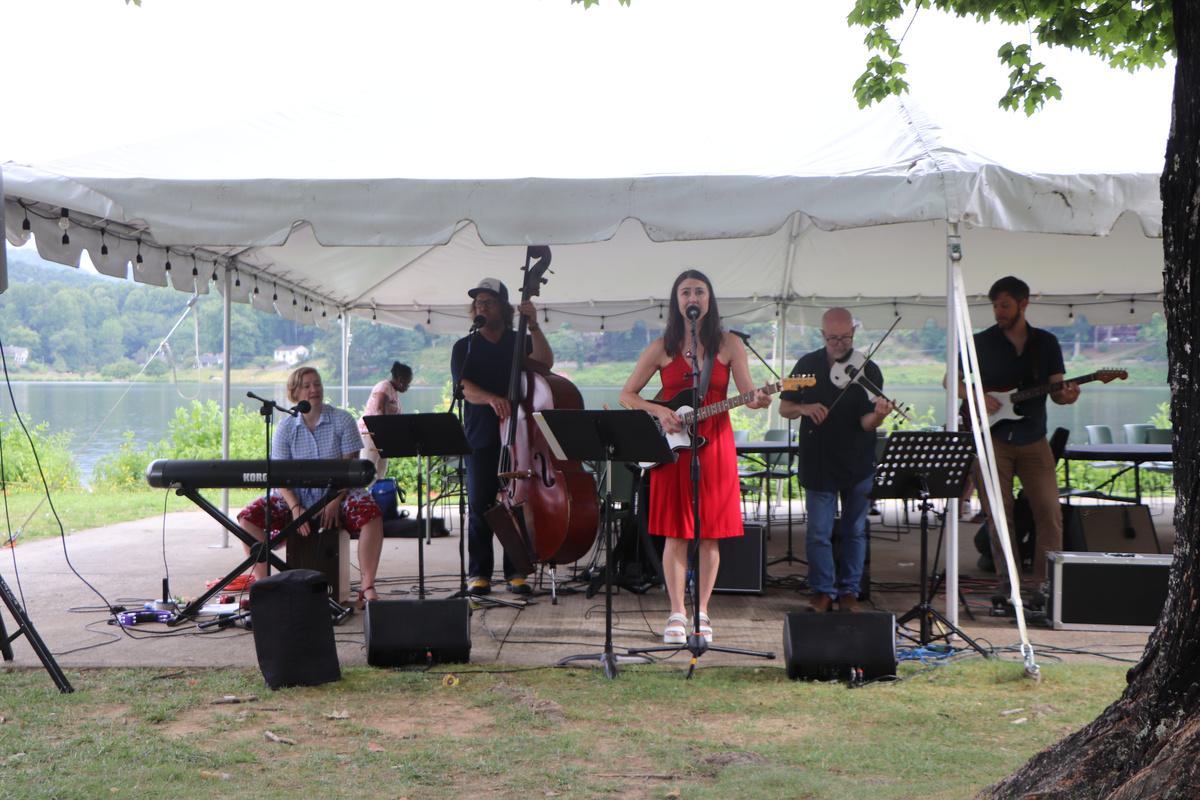
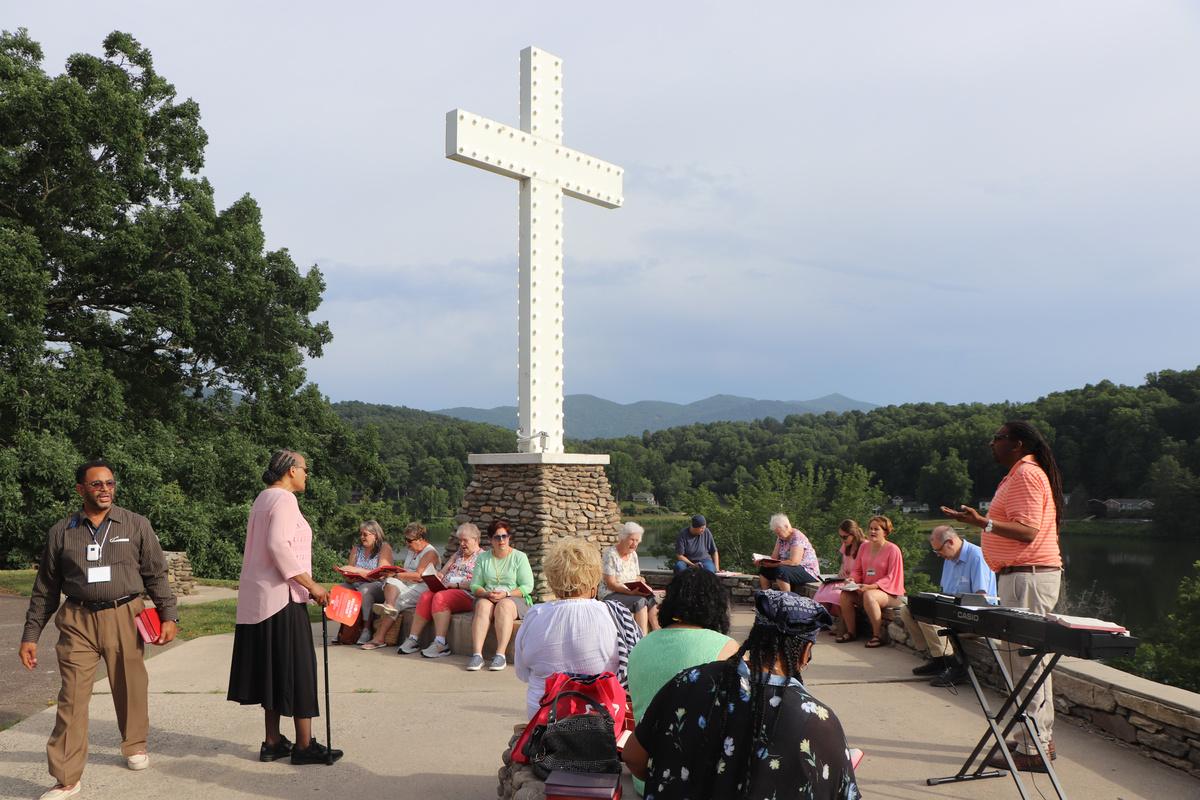
Photo taken by Lindsay Hampton.
Silent Dance Party where each person wears headphones and silently dances to the music

Photo taken by Aimee Yeager.

Martha Bassett playing live music at AC2022.
Photo taken by Lindsay Hampton.


Chris Hampton, Rev John Yeager, and Rev. Nathan Webb pause from their D&D game for a photo opp.
Photo taken by Lindsay Hampton


Testimony of Hope from the Opening Worship service at Annual Conference 2022.



Bishop Carter asks the 2022 Ordinands the Historic Wesley Questions and explains what they mean.
Rev Annalee Allen is the 2022 recipient of the Francis Asbury Award.


Dr. Brittany S. Bethel is the recipient of the Harry Denman Award
Bishop Carter preaches on the future of The United Methodist Church.
The chorus of "I Can Only Imagine" sung at Annual Conference.


See more video highlights from the 2022 Annual Conference


In countless congregations and communities across the North Carolina Piedmont, the phrase, "the Northern Piedmont way," resonates. Preach it from the pulpit. Shout it from the town square. People of all faiths, particularly United Methodists, and even those whose faith may have waned in these troubled times will understand what you mean.
The Northern Piedmont Way is seeing your neighbor as your brother or sister regardless of color, class, culture or sexual orientation. It is feeding the hungry Helping churches master 21st Century technology Healing the sick, which during the pandemic meant promoting vaccinations. In bringing love to life, the bottom line is this: The Northern Piedmont Way means building a Beloved Community one soul at a time. This is what Christ calls the faithful to do.
It's right there in Ephesians, says Rev. Joe Hout, a pastor in the Northern Piedmont District Christ has broken down the dividing wall. The rest, Hout says, is up to us. “This is what we ought to do as followers of Jesus. This is part of the ethos of the Northern Piedmont District This is how we roll”
‘That We Live Together In Unity’ Amid the divisions in The United Methodist Church and the world beyond houses of worship, the story of the Northern Piedmont District is worth telling. And worth heeding.



Left: Displayed in the District Office are the 10 values that guide the mission of building the beloved community.
The district is home to 37,000-plus United Methodists in 130 churches primarily in Guilford, Rockingham and Randolph counties. The district office is in Greensboro, a fitting city from which to pursue unity given its pioneering place in the Civil Rights Movement. Rev. Bev Coppley has served as District Superintendent since July 2018 But she is quick to note that this movement is bigger than her She describes the Northern Piedmont Way as a “continuity gospel” nurtured by her predecessor, Rev. Nancy Rankin, and clergy and laity past and present.


Inclusion defines the Northern Piedmont Way. Of the district’s 110 active pastors, 42 are women and 29 are clergy of color. Twelve serve in crosscultural/cross-racial appointments, a pastor leading a congregation of a different color or culture, both clergy and laity enriched by the experience. The numbers are a tangible expression of the district’s commitment to reconciliation and equality So are the initiatives we are about to chronicle.
As The United Methodist Church talks of building the Beloved Community, Coppley shares her vision of what that means: “That we live together in unity, no one more beloved than anyone else.”
What’s going on in the Northern Piedmont District?


While growing in frequency across United Methodism, the dozen cross cultural/cross racial appointments in the district stand out. One chapter in the story: Rev. Joe Hout is white. He leads St. John United Methodist in Eden, a largely African American church He also leads Salem United Methodist Church in Reidsville, which is largely white.

Talk about a double blessing “I’m ridiculously honored,” Hout says
Hout works to weave together the life of the two small congregations. On the fifth Sunday of the month, they worship as one Vacation Bible School brings together black and white children to learn what it means to love and serve God. From the pulpit and in informal settings, he isn’t afraid to initiate difficult conversations about racism past and present But who says coming together can’t be fun? There are volleyball games open to all. Coming from a family of jugglers, Hout has led a class on this lost art. “It was a hoot,” he says
Worship. VBS. Volleyball. Keeping three balls in the air at once. Bringing people together can’t be any trickier than that last one. This is how Hout describes the Beloved Community: “All people welcome.”
As pastor of 30-member Zion Hill United Methodist Church in Colfax, Rev. Linda Moore appreciates the power of working with others. It’s part of the ethos of the Northern Piedmont District. Her congregation, for example, has joined with members of St. Timothy’s United Methodist in Jamestown for a hymn sing and missions fair. Nothing beats making s’mores and belting out “What a Mighty God We Serve” with new friends Or distributing a truckload of potatoes to neighbors in need. Or gathering up everyone’s cats and dogs for a Blessing of the Animals District churches and clergy also work with the Beloved Community Center in Greensboro to give voice to the marginalized through programs on economic justice and equal opportunity
Moore appreciates how the Missional Network – Guilford West in her church’s case – brings congregations together There is strength in numbers, especially


when those numbers are as diverse as the world we seek to transform.
“We can do a whole lot more together than we can separate,” she says.
Given the subject matter – the power of working with others – Moore needed just one word to end the interview for this story

“Hallelujah.”
When Rev. Maria King joined the district staff in 2013 as Vitality Associate, she was encouraged to think outside the box. To do her own thing. Collaborating with clergy and laity, she has helped guide the district in a number of inventive initiatives
During the pandemic that meant promoting vaccinations. Partnering with the Guilford County Health Department, district volunteers helped communities
of color understand and embrace vaccinations The effort included making sure clergy and congregations had access and transportation to vaccination sites. As part of a broader effort in the Triad region to vaccinate 3,000 people a day, district volunteers helped make appointments. What’s that saying, God is in the details? The district also distributed masks and sanitizers in communities of color
Minorities have long suffered from unequal access to health care. The past is stained by the inhumane treatment of African Americans The shame of the Tuskegee Study of 1932 is still recalled by many, allowing black men with syphilis to go untreated. Throughout the pandemic, King says, “We were bringing to the table the history of racism and vaccination. I hosted many Zoom calls for communities of color to ask questions of health professionals and find comfort during the vaccination process.”
After the pandemic, the mission continues The district is working with the Guilford County Health Department to set up mobile health clinics.



Another faith dimension to the pandemic: It forced congregations to reach people in nontraditional ways –livestreaming worship, Sunday School via Zoom and the like. Some churches, though, needed to catch up with technology To help congregations of color, the district made use of a grant from the Reynolds Ministry Fund of the United Methodist Foundation of Western North Carolina Technology was installed where it was needed, and church staff and laity were trained to press the right buttons.
Below: NP leaders and community members at Mt Carmel UMC breaking ground after the church building burned to the ground in a fire


As Aimee Yeager, the Conference’s Director of Communications, says, “This project turned traditional lines of access, influence and mobility on its head by lifting churches of color to become lines of information, power and voice.”
“How can people transform, grow and move?” King asks. The district’s School of Spiritual Direction Beyond Borders offers one answer, training clergy and laity to become spiritual directors for their community Listen for God’s direction in your life. Listen to your fellow man’s story. Dare to go beyond the borders of your life and learn from people of other cultures and backgrounds That’s a lot to tackle at six training retreats over two years. Rev. Allan Van Meter is among the 50 clergy and laity (and counting) who can testify to its worth
Van Meter, who leads Mount Pleasant United Methodist Church in Greensboro, says the school reminded him of a lesson that is easily overlooked in the busy-ness of a pastor’s day. He’s given it a name. TAG. Time Alone With God. “It’s about letting God work through us, Christ work through us, sharing the light,” he says.
In the morning, Van Meter reads Scripture, then takes a walk, noticing nature and pausing to chat with his neighbors During a day filled with meetings and more meetings, he pauses to take a breath and remember the Scripture he read that morning. At day’s end, he turns off the computer and TV for something better.
“Hearing God’s voice before I go to bed.”
Van Meter has drawn strength from the school, and passion to lead his congregation into the community. In that spirit, church members earlier this year welcomed teachers from Eastern Guilford High School for a meal and fellowship.
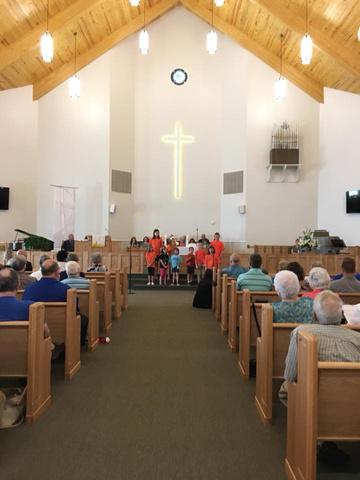
The Beloved Community? “It’s a place where all people are loved and welcomed,” Van Meter says.
The Northern Piedmont District began offering classes on discipleship and trauma in 2021. Violence both physical and verbal. Bullying. Being belittled. Prejudice. Hunger. Loneliness. Grief. The shock of sudden loss. “This healing was about more than the pandemic but generations of trauma from our history,” says King, who leads the class.


“I knew emotionally, physically and spiritually we needed to find pathways of healing together.” Whatever the trauma, healing lies in understanding that we do not suffer alone. “It’s a sense of being held by God instead of holding on to God,” she says
Brenda Ray of Greensboro, who attends Metropolitan United Methodist Church, was among 20 classmates who told their stories over two weekends. They shared compassion without judgment. They learned different ways to deal with trauma: Deep breathing Ice packs on the upper part of the chest Letting go of your burdens, or at least trying to. Finding peace in helping others find their peace.

The course is now offered across the Northern Piedmont District.

Says King, “It is time to know the beauty of the Beloved Community, which is healing and loving.”
Tough times call for clever slogans. In a world in which we are bombarded by posts and pleas screaming at us to believe this or buy that, capturing a movement in a few words is important. When that movement is sharing God’s love it is downright noble So it is with The United Methodist Church.
Globally, #BeUMC is lifting up WorldChanging People Of God. In nearly 43,500 churches in 45 countries, 13 million United Methodists are responding to disasters, challenging the status quo, and loving people others have forgotten. The faithful, including a quarter-million strong in the Western North Carolina Conference, are telling these stories on social media platforms, that others might be moved to embrace the mission. Visit www.wnccumc.org/beumc and discover the videos, photos and stories that express what it means to #BeUMC
And then we come to the Northern Piedmont District, a collection of many small (and a few large) congregations trying to do big things. Heal hurts. Shatter the walls of division. Harness technology. Build trust for health care in all communities. Help us hear God above the din
The Northern Piedmont Way. The Beloved Community. Cosmic aspirations, summed up in a few words captured by the district’s superintendent, Bev Coppley. “That we live together in unity, no one more beloved than anyone else.”

Ken Garfield, former Director of Communications at Myers Park United Methodist Church, is a freelance writer/editor in Charlotte, N.C. Reach him at garfieldken3129@gmail.com.




The current moment for United Methodists is one that is hard, painful, and maybe even scary, as thousands of United Methodist churches across the globe petitioned for disaffiliation in 2022. One might think the word of the year for The UMC would be “disconnected.” Yet, amid all the noise of separation, Bishop Carter heard cries for deeper connection.


“I began to hear the stories of United Methodists whose churches were planning to depart from the denomination,” Bishop Carter recalls, “and yet they had a deep love for our church and a desire to stay in connection with it –a couple in a small town, a woman in a very rural area, an entire Sunday School class. I imagined a resource that would keep them on a path of spiritual growth as United Methodists and in connection with others of a like mind ”
The first step towards making this imagined resource a reality was to find a person who could take the idea and run with it

That person needed to be someone who knew Methodist history and tradition, so they could appropriately define and understand this moment in the life of The United Methodist Church. It needed to be someone who understood the value of relationships and connection when it comes to Wesleyan discipleship The person that came to mind for Bishop Carter was Dr. Steve Harper, a retired Elder in the Florida Annual Conference whose ministry has taken the shape of youth minister, evangelist, pastor, parachurch ministry founder, church agency staff member, and theological educator. Dr. Harper currently serves as professor of Wesleyan Studies and Director of the Wesleyan Studies Program for Northwind Theological Seminary in Sarasota, Florida.
“Bishop Carter reached out to me initially because he wanted spiritual formation in the Wesleyan tradition to be at the heart of the movement,” Dr. Harper shares, “and he knows that has been the focus of my teaching and ministry for over forty years.”
Dr. Harper took on this mantle and began to build something that would serve as a place of belonging, connection, and discipleship for those who found themselves without a church home for, perhaps, the first time in their lives
Dr Harper continues, “Bishop Carter expressed concern for all who would feel ‘homeless’ as their congregations disaffiliate, but who want to remain in The UMC ”
This idea of connection, of home, for those who felt disconnected, hurt, and alone, began to take form in what is now UMsConnected
UMsConnected, an online and inperson ministry that seeks to help United Methodists feel less alone, was first birthed in the Florida Conference and then expanded to include the Western North Carolina Conference with Rev Kim Ingram, WNCC Director of Ministerial Services, coming on board as the co-director of UMsConnected. UMsConnected now expands far beyond these two conferences and is @UMsConnected
UMsConnectedcom


available to anyone, anywhere, even if they do not identify as United Methodist Rev. Ingram describes UMsConnected as “a balm for the soul” saying, “UMsConnected provides a place for laity and clergy to connect with others in this time of transition. The primary audience includes those who embrace Wesleyan theology as expressed by The United Methodist Church but find themselves without a Christian community at this time. It also provides a meaningful way for United Methodist leaders to connect and find support in divisive times.”
In September, UMsConnected started Kindred, which, according to ministry leader Rev. Christy Holden, “is a faith community for young adults, offering a time for spiritual growth, deep and open scripture discussion, and a place to meet people and develop relationships.”
In October, UMsConnected launched its first Epworth group, an online small group hosted by Rev. Nikki Raye Rice. While the online group is open to people anywhere, UMsConnected also offers a resource for those who want to start a local Epworth group in their community.

At its conception, UMsConnected was meant to be a waystation for those who found themselves in the liminal space between church homes. Recognizing, however, that this middle-place in a person’s journey is one that is deeply personal and contextual, it has sparked the imaginations of Annual Conferences across the nation, who are now intentionally building resources and communities that are designed to meet the needs of United Methodists in their local context.
If you find yourself displaced by a disaffiliating church or amid congregational debates on disaffiliation, we know how painful that reality can be We want you to know above all that you are not alone. You matter and your story matters. We recognize the importance of ministering to and with you in this season To stay connected or learn more about remaining UMC in the Western North Carolina Conference, please visit www wnccumc org/remainingumc.org.



Rev. George Melvin Coates was born in Cleveland County, NC on November 4, 1953 After graduating from Burns High School, he attended the NC Governor’s School and UNC Chapel Hill where he graduated with a Bachelor of Science in Biology and later returned for a master’s degree in Business Administration. His career started in banking, but he soon made a shift to nonprofit work, working with the United Way of Greensboro and Triangle United Way among other organizations. Then, in 2007, he answered a call to ministry and obtained his Master of Divinity from Hood Theological Seminary. George served in various roles in the Western NC Conference with his most recent being the

Chair of the Conference Committee on Finance and Administration.
His wife, Rev. Phyllis Coates, began her career in law enforcement with the Carrboro police department before meeting and marrying George. She continued to work for the department while George was attending his master’s program
Phyllis, however, was quicker to heed the call from God into pastoral ministry and began her first appointment in 2001. In fact, George’s first appointment would be as Phyllis’s assistant. It would not be until 2020 when they were appointed as co-pastors at Hickory Grove in Charlotte that they would serve together again at the same appointment. Despite their combined 35 years of service, they both rarely received compensation levels above the Conference minimum.
Up the road in Roanoke, VA on June 28, 1955, Charlene Adele Curtis was born Charlene loved academics, music, and sports. She was the first African American to join the Roanoke Youth Symphony in 1972. She attended, played basketball for, and graduated from Radford University. She was Radford's first African American women’s basketball player and first 1,000point scorer, male or female Later Charlene was inducted into Radford University’s Sports Hall of Fame as both an athlete and a coach. Charlene obtained a master’s in Secondary Administration from the University of Virginia in 1982. She would go on to be the first African American women’s basketball head


coach at Radford, Temple, and in all of the ACC when she was hired at Wake Forest in 1997. She then became the ACC's Supervisor of Women's Basketball Officials in 2008 until her retirement in 2019. The awards, achievements, and “firsts” of Charlene were numerous. She supported and volunteered with many nonprofit organizations over her career and when asked why, she’d respond, “Why not?” In addition to her work on the court, Charlene was an active member of St. Paul UMC in Winston Salem serving as Lay Leader for her local church and as the Chair of the Commission on Equitable Compensation on the Conference level.

Charlene Curtis (1955-2022)
I share these stories because both George and Charlene served on the Just Compensation Task Force
We also lost both George and Charlene this summer at the ages of 68 and 67, respectively When asked to write an article on the Just Compensation Task Force as an example of WNCC United Methodists living out their faith as “justice-seeking people of God,” I wanted to take the opportunity to lift up these two members of the task force who exemplified that title more than most
George and Charlene lived this out not only through their work on the task force, or through their positions chairing the Commission on Equitable Compensation and Council on Finance and Administration, but in all aspects of their lives They did this work while being compensated far less than their white, and in Charlene’s case also male, counterparts. And that part of their stories is not unique. Many women and people of color have had to blaze trails that should have existed long ago. They stand on the shoulders of those that have gone before them knowing that their shoulders, too, will bear those who come after them.
Among fully ordained elders serving in a local church, there are only 23 black elders, four Latinx elders,

two Native American elders, and four Asian elders.
Of the 33 full elders of color, half are already eligible for retirement. Black full elders serving full-time make, on average, about $14,000 less than their white counterparts and women about $12,000 less than their male counterparts. Even when adjusting for years of service the average gap is about $10,000 and $7,000 respectively
These stats only reflect the differences experienced in salaries. This does not even begin to speak to the trauma and abuse that women and people of color experience when appointed to congregations that did not want, or were not prepared for, a woman or person of color. Many women and people of color have shared experiences of salaries being lowered upon their arrival, lay members expressing dissatisfaction with a woman or person of color being appointed to their church, etc
Many of these issues cannot be addressed overnight. It has taken decades of these systems being perpetuated to get us where we are today. In order to move from where

we are to where we want to be, it will take an intentional effort by everyone involved. The burden especially falls on people, such as me, who are white males. We have benefited from a system of injustice even if we do not see ourselves as the ones who created or have not done anything consciously to perpetuate it


The creation of the Just Compensation Task Force is just one step our Conference has taken to address these injustices The Task Force has worked over the last two years to evaluate the inequality of salaries and to provide suggested actions The first, which was passed at the 2022 annual conference, was to implement longevity increases. This means that every five years of service the base compensation will automatically be raised While this will not completely close the salary gap, it will make sure that all clergy, but especially women and people of color, will see their salaries increase every five years and with each increase to the base minimum compensation.



The team will continue to work to identify other areas of improvement alongside the ongoing work of the Director of Equity and Justice Ministries, Rev Dr Bill White, Jr, and the WNCC Justice and Reconciliation Team
This work, however, takes all of us. The work cannot be outsourced to a committee, task force, or conference position. Each of us must take ownership of our broken system, and work to bring about justice and reconciliation. We must work to create a culture that affirms and respects the gifts of all and compensates everyone equally regardless of race or gender So, too, must we lift up those who are called into ministry regardless of race and gender This work is only a fraction of what we’re called to do and to be as justice-seeking people of God.

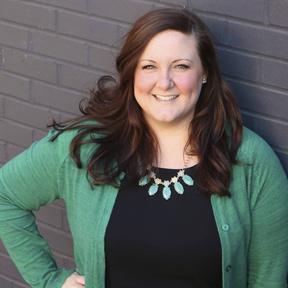


"And may you have the power to understand, as all God’s people should, how wide, how long, how high, and how deep his love is. May you experience the love of Christ, though it is too great to understand fully Then you will be made complete with all the fullness of life and power that comes from God " Ephesians 3:18-19, NLT
This scripture has been important to me through the years and my favorite version is the New Living Translation When I am in the mountains of western North Carolina or looking out over the ocean, I am reminded of this scripture. I often connect with God in the beauty and awe of creation.
My favorite scripture is Psalm 23: 4 & 6
"Even though I walk through the valley of the shadow of death, I will fear no evil for you are with me; your rod and your staff, they comfort me. Surely goodness and love will follow me all the days of my life, and I will dwell in the house of the Lord forever "

My daily question is always, “How is love showing up in the way I breathe, think, live, and share?” In these questions, I try not to judge myself, yet give a space to unlearn the wrong narrative and open up to a loving narrative To do this kind of soul work, I find my spiritual practices are nonnegotiable during my days and week.

I lean on 1 John 4:7-21 and Micah 6:8 to guide my steps: Love God. Love others. Do justice Love mercy Walk humbly When in doubt, I always aim to err on the side of love, justice, mercy, kindness and humility. As Eugene Peterson writes in The Message: "He’s already made it plain how to live, what to do, what God is looking for It’s quite simple: Do what is fair and just to your neighbor, be compassionate and loyal in your love, And don’t take yourself too seriously take God seriously."




Probably one of the most important disciplines for me is practicing the presence of God throughout my life, each and every day Being aware of God’s constant and abiding presence creates holy ground anywhere and everywhere. My faith is constantly evolving and am learning that it is ok to continue to discover, challenge assumptions, and ask the hard questions of God I think God takes delight in my questions because it means God is constantly on my mind.
I have always loved technology and have always been United Methodist Working for the conference office and getting to intersect the two has been one of the greatest honors of my life. I hope my gifts help churches and clergy find new ways to do ministry & make the administrative tasks we must all complete a little easier

I would describe my journey of faith as following Jesus, alongside his motley crew, to the places and the people God loves beyond the traditional boundaries of the church

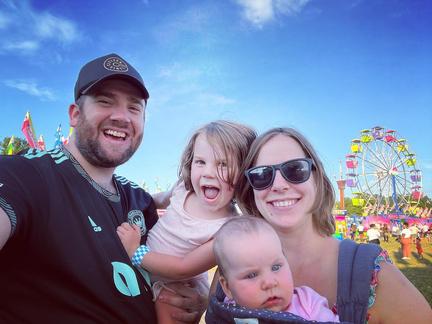
My journey with God up to this point has been a series of experiences of being surprised by God's grace; moments of feeling like I'm getting a nod from God in the midst of grief or doubt or deep stress; assurances that when I can't God is the Great I Am It's been an ongoing journey of moving faith in God from my head, and something I know a lot about to a lived and felt experience in my heart
When my faith seems to weaken, these two scriptures strengthen me:
"Trust in the Lord with all your heart and lean not on your own understanding" Proverbs 3:5
"I can do all this through him who gives me strength " Philippians 4:13

 BY AIMEE YEAGER DIRECTOR OF COMMUNICATIONS
BY AIMEE YEAGER DIRECTOR OF COMMUNICATIONS

On the Tuesday of Holy Week 2022, members of churches across the Conference gathered in Taylorsville to walk the execution path of Jesus. Facilitated by death penalty abolitionist, Shane Claiborne, and First UMCTaylorsville pastor, Rev. Joel Simpson, participants were led through the traditional fourteen stations of the cross On this night, however, the images for each station were far from traditional. These images portrayed the execution of Jesus as painted by the men awaiting their own execution on Tennessee’s death row
“This piece of art is a commentary on the continuing battle for our collective moral worldview,” says Derrick Quintero, one of the death row prisoners who participated in this project. “It is a collaborative effort with several of my fellow artists, all of whom reside on Tennessee’s death row Not all are Christians or even religious. Several chose to be anonymous.
I asked my fellow community members to help create this project to begin a conversation about what justice looks like.”Quintero died from cancer last year while living on death row.
Through collective sighs, gasps, and tears, a conversation on justice is exactly what transpired in Taylorsville. As Rev. Simpson and Claiborne walked the attendants through Jesus’ last moments prior to his execution with the visual aids of the prisoners’ artwork, they also shared their stories of ministering to and with prisoners on death row,
statistics for executions in the US, and the struggles and triumphs of advocating for alternate solutions to the death penalty.

Recognizing the power of the paintingssince so many of us will never have the same perspective as the men on death row - Claiborne and Red Letter Christians, the community he co-founded with Rev Tony Campolo, partnered with the prisoners to fight the systemic red tape to get the paintings out of the prison and available for public viewing It was a process that took around three years.
“Where you sit can determine what you see,” Claiborne said “Within these images is an invitation for what role the church can play – we who follow the One who said, ‘Blessed are the merciful.’"
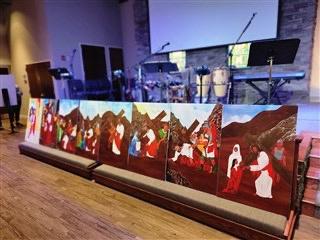
“As we watch Jesus fall under the weight of the cross,” Rev. Simpson pondered, “what better time to ask ourselves who are we crushing?”
Quoting a friend, Claiborne challenged the crowd to think about that very question.


“We think we’re killing the worst of the worst,” he said. “But really we’re killing the poorest of the poor.”
In the tradition of the Stations of the Cross, Jesus falls three times on his way to Golgotha. Rev. Simpson asked us to reflect on our own societal cycle of repetitions “We ended slavery and started Jim Crow. We passed the Civil Rights Act and fill our prisons [with black and brown bodies]”
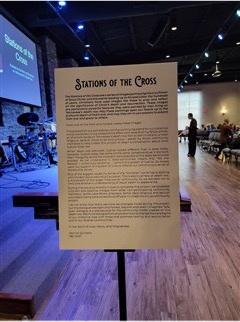
"Through it all,” Rev. Simpson asserts, “we hold on to the promise of redemption and the hope of Jesus”
How did Jesus get to the cross? Who is responsible for his execution? Judas betrays him The Sanhedrin put him on trial The crowds cry, “Crucify him!” Pilate washes his hands of responsibility while issuing the command to have Jesus flogged and crucified. The Roman soldiers oversaw the journey to Golgotha and the nailing of his hands and feet. Someone actually hammered the nails. Which of these holds the title of the executioner?
In the US justice system, a prosecutor calls for the death penalty. A jury finds the defendant guilty. A judge issues the sentence. The governor signs the death warrant The warden oversees the imprisonment and execution. Prison staff prepares the inmate for execution. The executioners implement the mode of execution And behind all of this are politicians who draft laws, courts who uphold laws, and citizens whose votes underscore and allow this entire process to take place.
“Everyone is a part of this system,” Claiborne reflects, “but no one wants to feel that they are responsible.”
Following the presentation, the floor was opened for audience dialogue and questions. One audience member, Mary,

shared a story of an inmate she knew who had come to terms with the fact that he was going to die in prison. “He accepted his fate, he just didn’t want to be buried at a state penitentiary,” she said. “So, he wrote to his home church to request burial in their cemetery The church denied his request.”
“We separate ourselves from those who are incarcerated, rather than putting ourselves in proximity with those who need our forgiveness and love…we’ve forgotten how to see people,” Rev Simpson reminded us all

According to Simpson and Claiborne, 90 percent of executions in the US occur in the so-called “Bible Belt”.
“We, as Christians, are why this practice still exists,” said Claiborne

Another attendee, Larry, remarked, “I’ve been in church 72 years and have never had a conversation like this in a church before.” After the event, Larry shared that he has always been a supporter of the death penalty, even at one time thinking he could be a citizen executioner with a clear conscious
“After tonight,” Larry said with tears in his eyes, “I don’t think I can ever support the death penalty again”
Larry continues, “If this [conversation] has been neglected for people like me, who have been in church their whole lives, something is missing”
“The transformation of our hearts begins when we pay attention to the hurt, the pain, and the suffering [of others],” said Rev. Simpson. “This is what we are doing when we look at the stations of the cross, when we are truly seeing Jesus' suffering. This is God paying attention to the hurt, pain, and suffering of the world by taking on this violence…As those who follow an executed and resurrected Savior, we want to be on the side of life, not death.”
The two faith leaders closed the session with this question, “What role will the church play in the abolition of statesanctioned executions?”
As we have these difficult conversations in
our churches, Claiborne reminds us, “You can’t change anyone’s mind by having an argument with them Minds are changed when hearts are changed through stories and conversations with the people whose lives are directly impacted”
“When Jesus was executed, justice looked different than it does today,” said Quintero. "However, justice today has some of the same components as it did back then. The guilty, as are the innocent, are subjected to this state-sanctioned process As we understand it, statesanctioned means that 'We the People' – collectively speaking –uphold this system of justice. So, based upon our support, this system of justice reflects our community’s sense of morals and values.”

As we journey to the cross with Jesus, let us all consider how we can build a system of justice that reflects our Church’s sense of morals and values – that all people are Divine image-bearers, that all life is sacred, and that no one is beyond the grace and redemption of our executed and resurrected Savior.
Find more resources related to the death penalty here


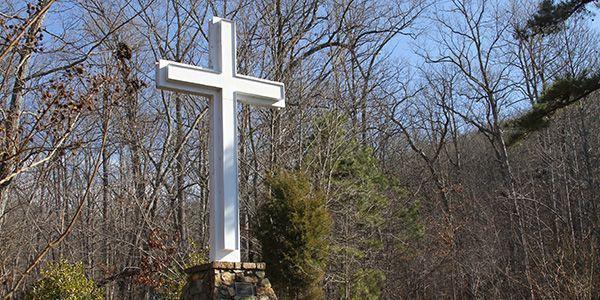




The lighted cross at Lake Junaluska has been an inspiration for countless people for 100 years. It has served as a sign of inspiration and hope to people who have attended conferences or retreats at the Lake, as well as to those who have seen it from the railroad Yet, the cross which shines over Lake Junaluska is not the original cross; the original cross is now at Mount Shepherd Retreat Center near Asheboro, while its replacement now illumines the Lake How did this series of events come to be?

According to Bill Lowry, the original idea for the lighted cross at Inspiration Point at Lake Junaluska was that of John R. McCrary, a Sunday school teacher from Lexington. He shared his idea with his friend, J B Ivey, who at the time was President of the Wesley Bible Class Federation of the Western North Carolina Conference. The two men presented the idea to the Federation, who embraced the challenge to raise the $500 necessary to construct the cross.[1]
On Monday, July 10, 1922, as the opening event of the Fourth Annual Meeting of the Federation of Wesley Bible Classes of the Western North Carolina Conference, the original cross at Lake Junaluska was dedicated.The cross was a gift of the Federation of Wesley Bible Classes of the Western North Carolina Conference and was presented to Lake Junaluska Assembly.[2]
“Following the dedication service, the lights were turned on for the first time. According to an oft repeated and printed story, when the lights were turned off in the fall, the commissioners received a letter from crews on the Southern Railway requesting that the lights be turned back on. In their letter, they indicated that as they passed the lake in the dark of night, the cross reminded them of their duty and the One who watched over them The Board granted their request and the lights remained on each night year-round.”[3]
“By the 1990s, despite frequent repairs and upgrades, it was obvious that [the cross at Lake Junaluska] had to be replaced.”[4] In early 1994 the original cross was removed to serve as a pattern for a new cross, which was designed, built, and donated by Mr and Mrs. Alfred Bohanon of Gastonia.[5] According to the article “New Cross at Missionary Point” in The Waynesville Mountaineer of March 28, 1994, the new cross was installed on March 25, 1994[6]
Following the installation of the new cross the question arose of what to do with the old cross While it was originally suggested that the old cross be placed in the Southeastern Jurisdictional Conference (SEJ) Heritage Center, the 25-foot-tall cross was too large to be placed in the Center For several years the cross lay on its side in various places on the first floor of the Harrell Center. The problem was finally solved when a petition was presented to the SEJ Administrative Council on behalf of the Mount Shepherd Retreat Center. The petition requested “a permanent loan” of the cross with the understanding that it would be restored and put into service at the Retreat Center SEJAC approved the petition in November 1998 and the original cross now stands at the entrance to Mount Shepherd.[7] Every night from 7 o'clock until midnight, the original “Lake Junaluska Cross” lights up the entrance to the Mount Shepherd Retreat Center.


The two crosses now bookend the Western North Carolina Conference From the Smoky Mountains to the North Carolina Piedmont, the lighted crosses stand as symbols of the deeply rooted faith of United Methodists in western North Carolina.




[1]Bill Lowry, “John Raymond McCrary: The Junaluska Cross,” in Stay Tuned: Junaluska Moments, pp. 75-76
[2] Joseph W Lasley, “A Brief History of the Lake Junaluska Cross,” August 6, 1994
[3] North Carolina Christian Advocate, May 17, 1923. Quoted in Bill Lowry, The Antechamber of Heaven (Franklin, TN: Providence House Publishers, 2010), p. 59
[4] Lowry, Antechamber, p. 171
[5]“Assembly Cross to Be Replaced by Private Donor,” The Waynesville Mountaineer, February 25, 1994

[6] Lowry, Antechamber, p. 171
{7] Letter from Kent Shrader dated October 15, 1998 and follow-up notes from Gerry Reiff dated December 11, 1998

 BY BEN ROGERS
WNCC MISSION RESPONSE ASSOCIATE
BY BEN ROGERS
WNCC MISSION RESPONSE ASSOCIATE

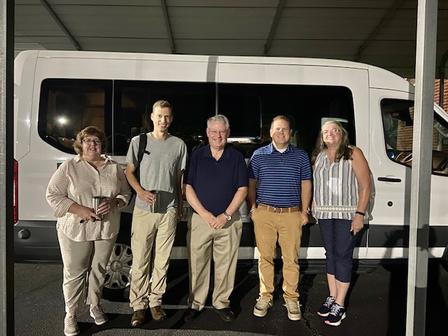

August 17, 2022 marked the first anniversary of the Pigeon River Flood in Haywood County Heavy rains from Tropical Storm Fred caused the river to rise to over 20 feet compared to roughly 2 feet the days prior. In the days following the flood, Cruso UMC transformed into a hub for search and rescue teams, a family meeting point, a distribution center of relief supplies, and a pit stop for individuals looking for a hot meal. One year to the day, Cruso UMC is still a beacon of light for the community Community members and volunteer rebuilding teams are invited each Wednesday to enjoy a hot meal. The walls of the dining area are lined with tables overflowing with donated canned goods, cleaning supplies, and even fresh produce from local farms.
Volunteers have been helping the community rebuild since the days following
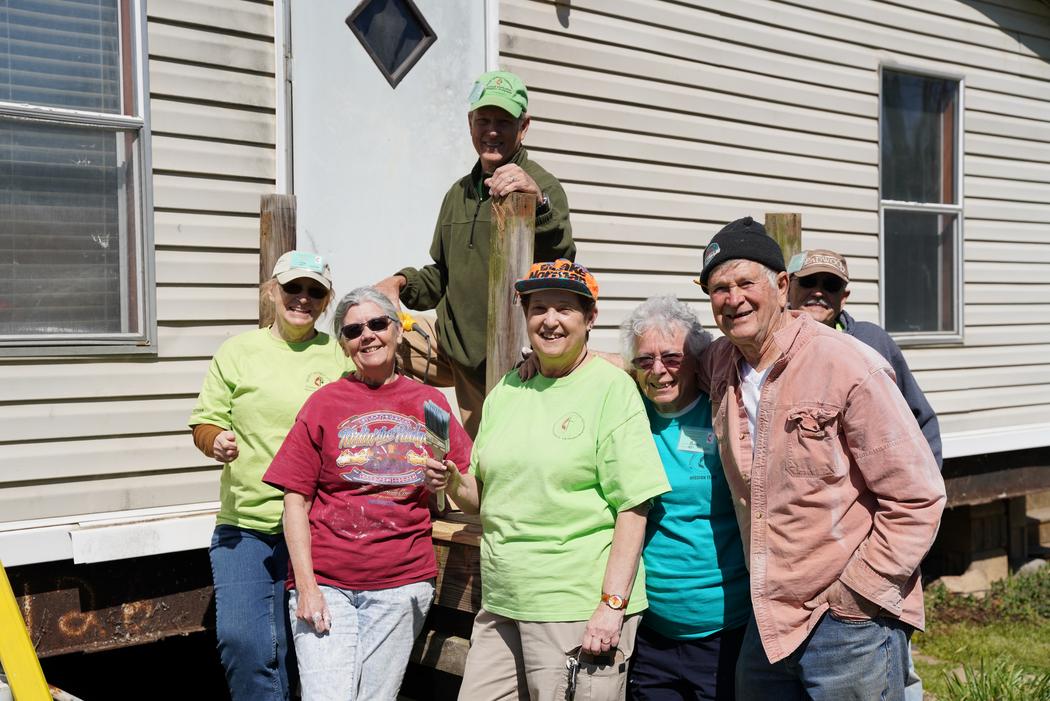

the storm, and we are now scheduling teams through March of 2023 If you would like to learn more about the work happening in Haywood County, reach out to Ben Rogers at brogers@wnccumc.org.




“My life changed for the better when I moved to Miami in August of 2021,” Amber Kupfer, 23-year-old Global Mission Fellow states on her one year anniversary of moving to Florida
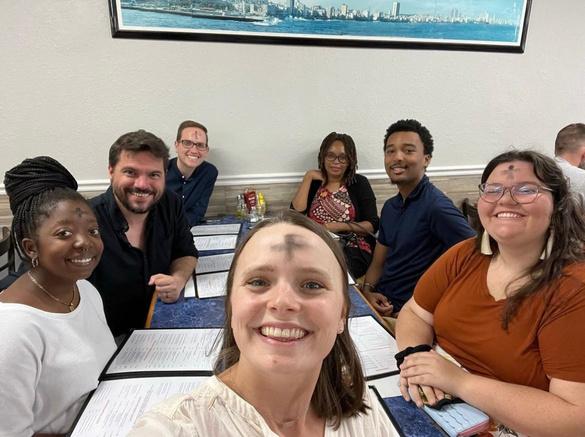

Amber grew up in Charlotte attending St. Stephen UMC. She was very active in the youth group, youth choir, and sports led by the church After graduating from UNC Chapel Hill in May of 2021 with a degree in Biology with minors in Chemistry and Cognitive Science, she found herself wondering what to do now that college was over She had wrestled with her call to ministry since she was participating in the children’s programs at St. Stephen. At UNC, she even held leadership positions in the UNC Wesley Foundation
“I’ve always been interested and involved in church,” Amber said via Zoom when we spoke with her “The Global Mission Fellows program seemed like something I would definitely be interested in. I had a friend that was in the program, so I talked to him about the pros and cons. I love to travel and in this program we can get placed anywhere. I couldn’t decide what to do or where to go after college so this way, someone could just tell me what to do!” she joked



Amber is currently placed at First UMC in downtown Miami with two other Global Mission Fellows. She is serving as their children and youth coordinator so she oversees nursery-aged through high school-aged kids. “I love it here. I live with the two other girls in the program. We are lucky because not everyone in the GMF gets to have roommates where they’re serving The importance of community has been super transformative in this experience.”
When asked what her favorite part of her job is, she smiled. “Well, First UMC is so supportive and inclusive, not only theologically, but also they’re diverse in ethnicity, age range, socioeconomic status, etc
And we are going through a huge renovation project right now. The church sold their property and are building a high-rise in its place. The first 13 floors will be the church and then the top 30 floors will be apartments. I love how this community believes in church not having to just be a building Church is more of a community rather than a place. We’ve really lived into that at First since our property is being renovated and we haven’t had a consistent place to worship for a while now. Right now, we are partnered with another United Methodist Church and are sharing their building by worshiping together ”

As do all of us, Amber has had some challenges in ministry. She laughed when explaining “Miami time”: People in Miami are always hours late to events and end up staying well past the time that it’s supposed to finish. “It was shocking at first because I had a youth event from 12-2pm and the first person showed up at 1:40pm and then they all stayed until around 4pm I’ve really had to be okay with everything not going exactly according to my plan. My perfectionist self struggled a little bit But it always works out in the end! My main goal is to just love the kids. Sometimes that means adapting to their culture and what works for them.”
Amber has some great advice for young adults being called to ministry in today’s world: “Get out of your comfort zone. Try something new. I had no idea what I was doing or what it was going to be like when I started this program. You’ve really got to be comfortable being uncomfortable. The best things can come out of those experiences

It’s also so important to remember that the children are our ‘now’, not our future. They deserve to know they’re loved and not alone. By reminding them of that, you’re also reminding yourself that you’re also loved and not alone. Working with these kids and this staff at FUMC has been transformational. I’ve become one of the best versions of myself this year and love who that person is.” Amber Kupfer will finish her program serving as a Global Mission Fellow in Miami in August of 2023. She would love to become a full-time staff member at FUMC and/or potentially go to seminary in the future. Amber was commissioned to service in the Florida Annual Conference in June 2022 Amber is a great example of God working through the young adults in our world.



Now in its 35th year, Carolina Cross Connection puts young people on the front lines of social change - with a new emphasis on serving communities of color.
 BY MATT GARFIELD DIRECTOR OF COMMUNICATIONS, UNITED METHODIST FOUNDATION
BY MATT GARFIELD DIRECTOR OF COMMUNICATIONS, UNITED METHODIST FOUNDATION
Of all the ways Caroline Vassil could choose to spend her summer break, you might think sawing lumber would rank somewhere near the bottom of the list.
Yet here she was on a July afternoon in rural Gaston County, sizing up boards to install a wheelchair ramp at the home of an elderly couple. Under a blazing sun, with temperatures reaching into the mid-90s, Caroline was exactly where she wanted to be.
“It’s actually pretty fun to build all this stuff,” she said “You learn all these skills you can’t really learn just playing at the pool.”
In rural, isolated corners of North Carolina, youth volunteers like Caroline deliver hope and find inspiration in God’s call to love our neighbors.
It has been this way since 1987, when Carolina Cross Connection debuted its first summer mission camp in support of folks who are some combination of disabled, elderly and economically disadvantaged.
When the workday ends, youth return to camp for worship, prayer and small group reflection on what they learned. Then it’s up at 7 a.m. to do it all again.
A central part of the mission is to build relationships with homeowners.
“It’s an eye opener, I guess you could say,” said Catie Black, who, like Caroline, is part of the youth group at Light of Christ UMC in Charlotte’s Ballantyne area. “Getting to meet the people we’re working with, and learn their stories, is the most rewarding part.”
CCC has welcomed 31,550 campers from as far away as Texas, Florida and New Jersey However, 90 percent of the youth groups that attend camp are from United Methodist churches in North Carolina.
The Foundation’s Reynolds Ministry Fund serves as a catalyst. Grants help to expand the home repair program and provide training for college-age summer staff.

In February 2021, CCC confronted an uncomfortable realization. A diversity and inclusion team found that while the organization serves some of the poorest areas in North Carolina, a disproportionate number of projects had taken place in predominantly white counties.
In response, board leaders created goals and target areas to grow into communities with both high levels of poverty and racially diverse populations, to ensure that campers serve all of God’s children in a balanced way
“We want to broaden the table – for more people to feel welcome and invited in,” said executive director Brittany Bethel, part of the staff since 2004
CCC operates an urban ministry in Asheville in partnership with Haywood Street Congregation A third program, Overseas Ministry, sends young people to work in
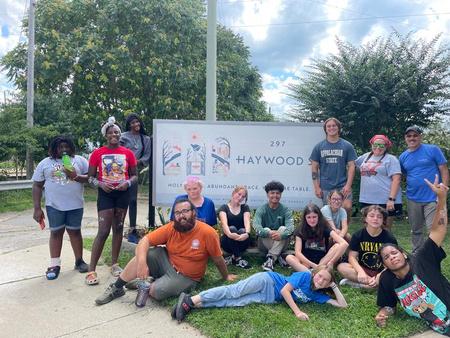

the Honduran villages of San Pedro Sula and Copan
Camp has become more challenging in the pandemic era but also more needed than ever. Students are suffering from loneliness and depression. Many have lost a meaningful connection with the church. At the same time, the needs of folks on the margins have only increased That’s why it’s so important for teens to see firsthand what it means to be the hands and feet of God.
“They learn a lot about the way other people live – and how we can better live together,” said Salem Sheridan, a former camper who now serves on the staff “There’s not many times they’re able to be in a community focused on Christ and serving others. And they gain a lot of skills that are kind of cool.”
 BY LINDSAY HAMPTON ASSOCIATE DIRECTOR OF COMMUNICATIONS
BY LINDSAY HAMPTON ASSOCIATE DIRECTOR OF COMMUNICATIONS

"We saw a need in the community and decided to act on it," Debbie Black, Certified Lay Minister at Mt. Pleasant UMC stated. Mt. Pleasant UMC - Kimesville located in Liberty (Northern Piedmont District) is a rural church that strives to reach more people and focus on building relationships within their community under the leadership of their pastor, Rev Keith Edwards
One of the many ministries that this local church puts on is a relatively new after school program for children and teens of all ages. During COVID, Guilford County Schools discontinued their after school program leaving parents with limited options for after school care for their kids

After talking with multiple families who were struggling to find a solution, Mt. Pleasant staff and leadership took action by partnering with the Boys and Girls Club of High Point to provide free care for children and teens ages Pre-K to 12th grade.



Thanks to a grant provided by the Boys and Girls Club, children are able to participate in this program at no cost to them With the help of volunteer leaders, many things are offered to the kids including free tutoring, homework help, free field trips, as well as dinner every evening! They average about 50 children in the program each day.
However, the vision didn't stop there. Mt. Pleasant had declining children's and youth participation in their church prior to offering the after school program. Once they saw how many kids were attending their campus after school, they decided to change their children and youth weekly gatherings from Sundays to Wednesdays This way, the kids in the after school program could also participate in the children's and youth ministries of the church while they were there. "It just seemed like a no brainer," Debbie explains. "We already had the children there...we just needed to start feeding them into our ministries."
Mt. Pleasant continues to find ways to serve by offering ministries based on needs that they identify within their local community. The staff and leadership try to always say "yes" when brainstorming new ideas, no matter how "out of the box" it may seem. Thank you, Mt. Pleasant, for offering what is needed in Guildford County to grow and expand the missions and ministries of God!
During the first week in November, delegates, bishops, & staff from the 14 Annual Conferences of the Southeastern Jurisdictional Conference gathered at Lake Junaluska for the purpose of electing new bishops and assigning episcopal leadership for each area.

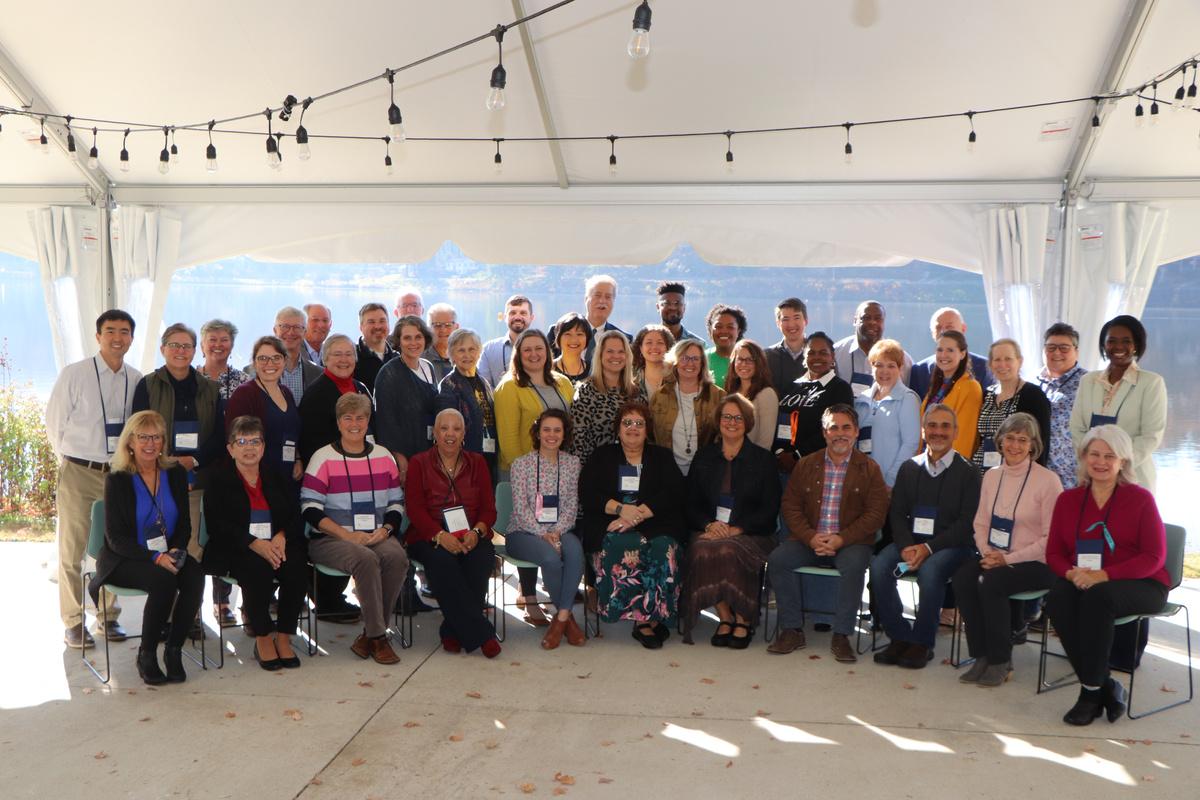
Due to COVID restrictions during the past three years, Jurisdictional Conferences had not been able to gather for this important work, and several bishops faced mandatory retirement during that time

In November, delegates from the SEJ Annual Conferences elected three new bishops - Rev Thomas Berlin, Rev. Dr. Connie Shelton, and Rev. Dr. Robin Dease.
You can read more about the work and events of SEJ 2022 in the newsletters linked below.


Nov. 2 Daily Christian Advocate
Nov 3 Daily Christian Advocate
Nov. 4 Daily Christian Advocate

With the absence of General Conference prior to SEJ22, the delegates heard from each of the episcopal candidates during "round robin" interviews on the first day of the conference. Here, Rev. Amy Coles speaks to one of the delegations during Tuesday's interviews.


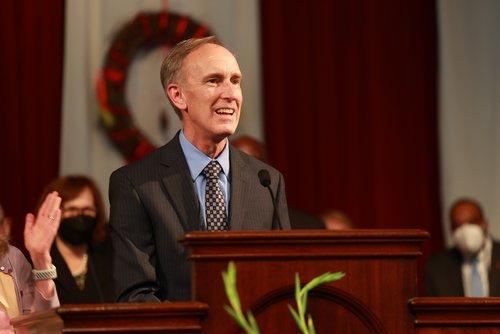
The Southeastern Jurisdictional Conference had its first election on ballot number four With 213 votes, Rev Thomas Martin Berlin was elected a bishop in the SEJ Bishop Berlin has been assigned to serve the Florida Conference
The SEJ had its second election on ballot number 12 With 213 votes, Rev Dr Connie Mitchell Shelton was elected bishop in the SEJ Bishop Shelton has been assigned to serve the North Carolina Conference




The SEJ had its third and final election on ballot number 25. With 206 votes, Rev. Dr. Robin Dease was elected a bishop in the SEJ. Bishop Dease has been assigned to serve the North Georgia Conference.

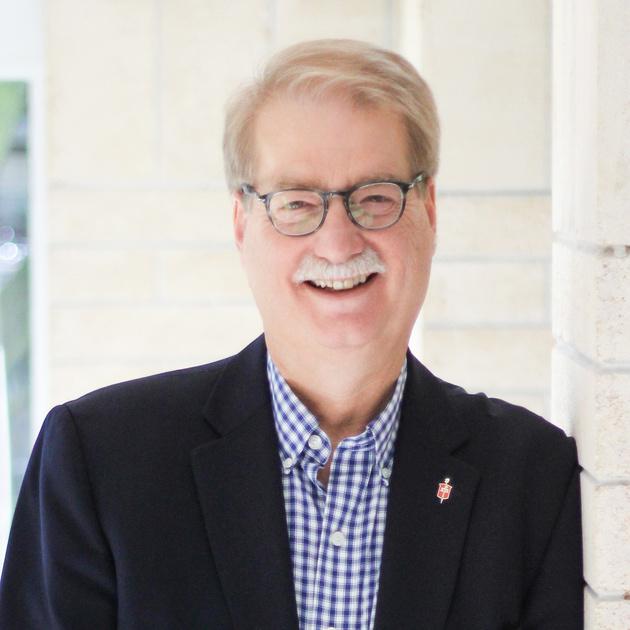
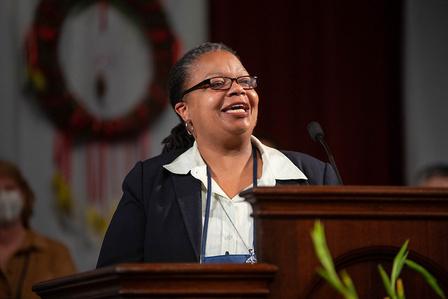
In the U.S., UMC bishops are elected for life. All active and retired bishops of The UMC make up the Council of Bishops Here Bishop Leeland, former bishop for the WNCC, and Bishop Carter, current bishop for the WNCC, have a moment for conversation
Effective January 1, 2023, Bishop Carter will end his residency in the Florida Conference and return to serve the Western NC Conference full-time
“I am thrilled to continue serving in Western North Carolina. This was the conference that accepted me as a candidate for ministry, ordained me and gave me opportunities to be mentored by extraordinary lay members of local churches and by clergy with very different strengths and gifts I claim the promise “the God who began a good work in us will be faithful to complete it” (Philippians 1. 6) and I am filled with hope for all that is to come.”
-Bishop Ken Carter



Every Sunday, in my United Methodist church, we stand and communally pray aloud
The Lord’s Prayer – the words Jesus taught us to pray – but what does this tradition mean to us, or for us?
John Wesley once referred to prayer as “the grand means of drawing near to God;”[1] it is “the breath of our spiritual life.”[2]
As I stand to recite this prayer from memory each week, does it draw me nearer to God or become a
breath of fresh air for my spirit? If I’m perfectly honest, the answer is almost always no Most Sundays, I repeat the words, “Our Father, who art in heaven ” as my brain starts to drift on to the floral arrangement behind the pulpit or whatever it is my child is doing to distract the worshippers in the pew behind us
What if we took the time to reacquaint ourselves with the intimacy of this prayer? How would it change our posture towards God? How could this weekly moment of communion with God breathe breath into our spiritual lives? How might an intimate encounter with this prayer help us to live into our baptismal vows to participate in the lives of our local congregations more faithfully?
As United Methodists, we are praying people of God. Every one of us who has been in church long enough knows the power of prayer through a church elder, a Sunday school teacher, or the hands of our family of faith on the shoulders of one who is grieving. Prayer changes us. It softens our hearts, shifts our perspective, and moves us to action
“Lord, teach us to pray,” the disciples requested of Jesus “This then, is how you should pray ”
[1] Letter to Miss March, 3–29–1760
[2] NT Notes, I Thes 5:16

Annual Magazine of The Western NC Conference of The United Methodist Church

The Western North Carolina Conference of The United Methodist Church wnccumc.org
Aimee Yeager, Director of Communications
Lindsay Hampton, Associate Director of Communications